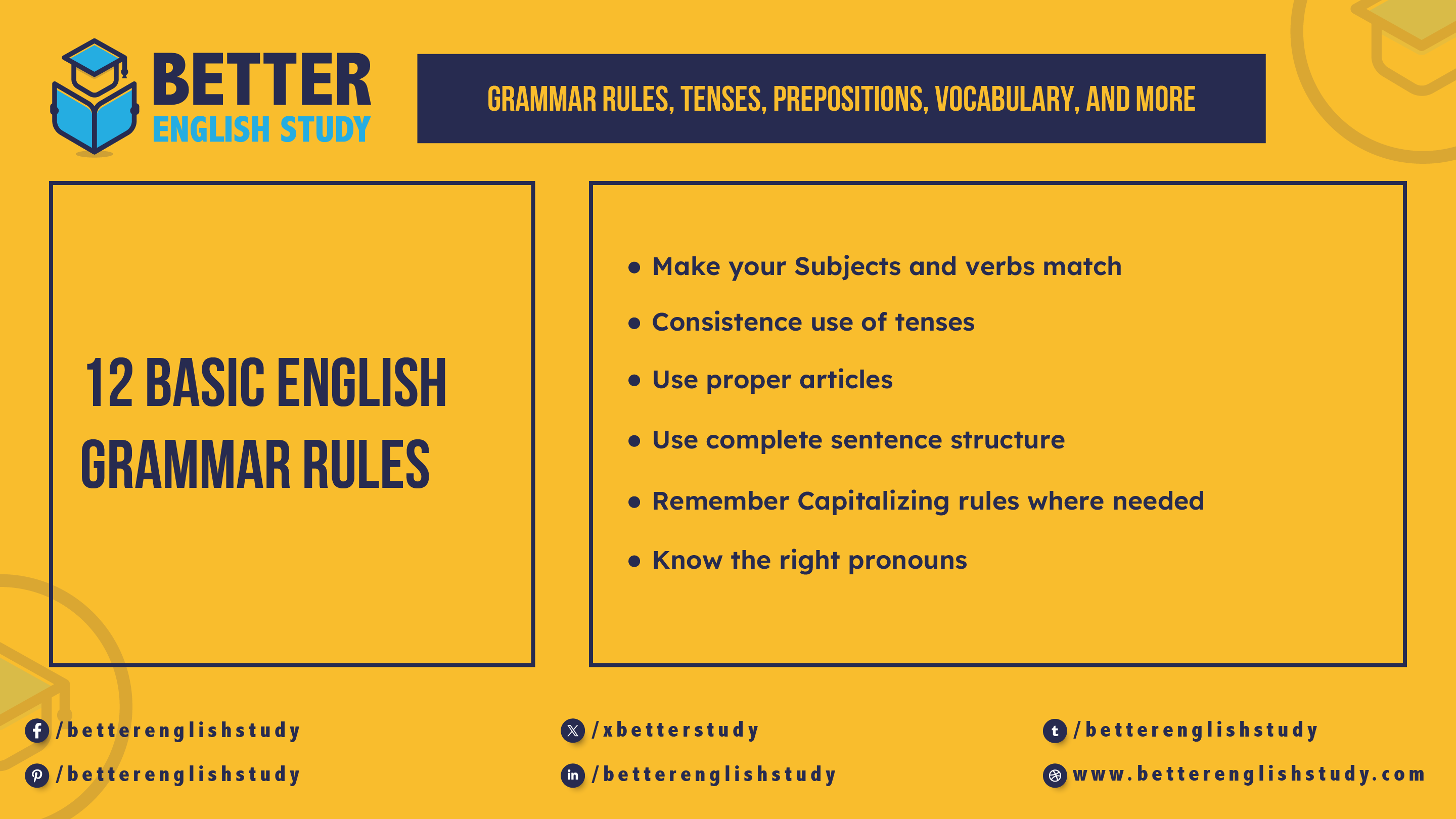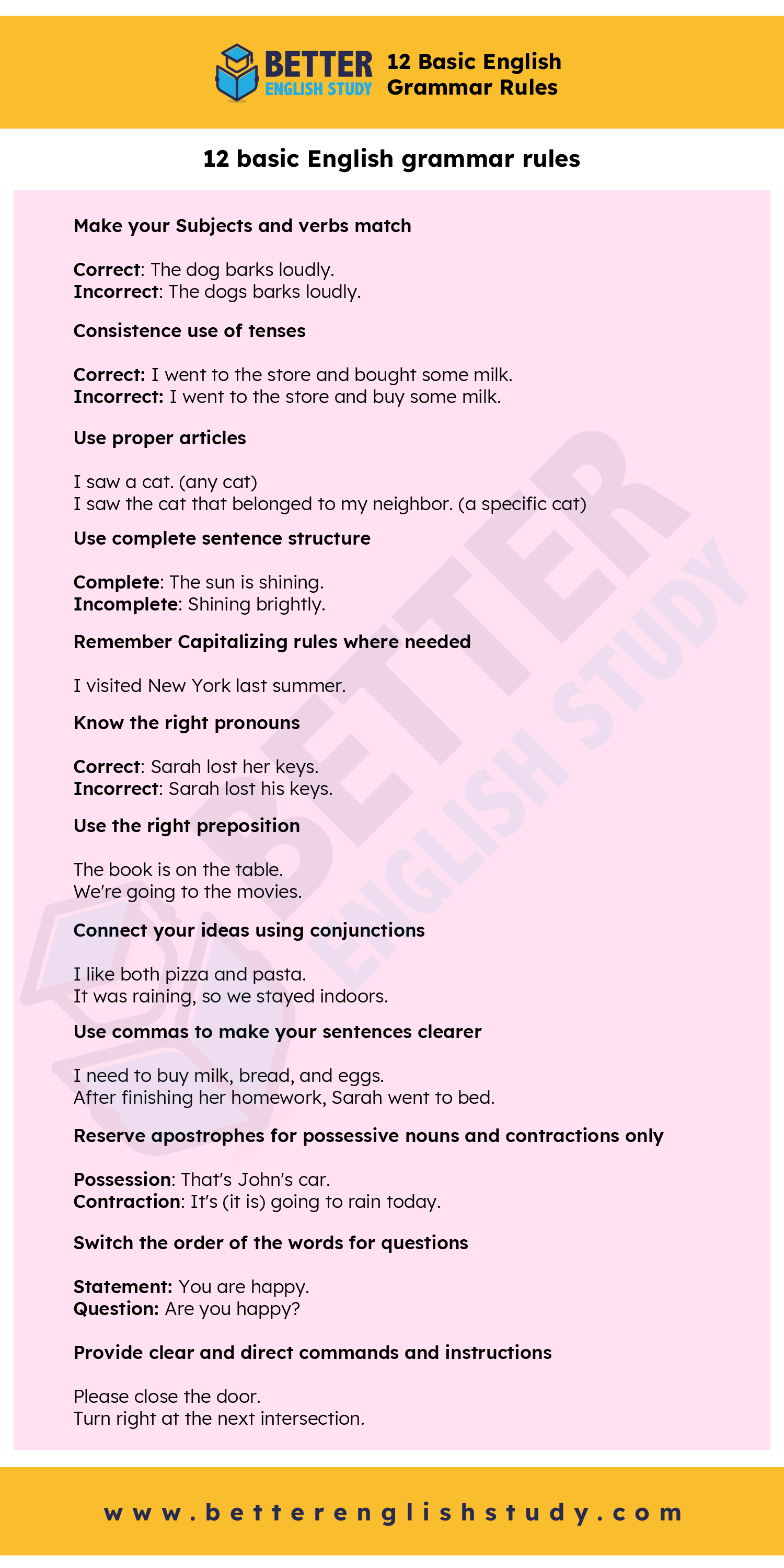
Are you looking to master the basic rules of English grammar? Do you want to understand all the English grammar rules correctly? You’ve come to the right place!
In this article, we’ll explore twelve fundamental grammar rules that will help you communicate more effectively in English.
What is grammar?
Before we dive into the rules, let’s clarify what grammar actually is.
Grammar is the set of structural rules that govern the composition of clauses, phrases, and words in any given language. It’s the foundation that helps us construct meaningful and coherent sentences.
Why Do you need to study the rules of grammar?
You might wonder if studying grammar rules is necessary. The answer is yes!
Understanding grammar helps you express yourself clearly and avoid misunderstandings. It’s especially important if you’re learning English as a second language or aiming to improve your writing skills.
Twelve basic English grammar rules
Let’s explore the twelve essential grammar rules that will elevate your English proficiency:
1. Make your Subjects and verbs match
Ensure that the subject of your sentence matches the verb in number. For example:
- Correct: The dog barks loudly.
- Incorrect: The dogs barks loudly.
Explanation: In the correct sentence, the singular subject “dog” agrees with the singular verb form “barks.” In the incorrect sentence, we have a plural subject “dogs” but a singular verb form “barks,” which creates a mismatch. The correct version for a plural subject would be “The dogs bark loudly.”
2. Consistence use of tenses
Maintain the same tense throughout your writing unless there’s a good reason to switch. For instance:
- Correct: I went to the store and bought some milk.
- Incorrect: I went to the store and buy some milk.
Explanation: In the correct sentence, both verbs (“went” and “bought”) are in the past tense, maintaining consistency. In the incorrect sentence, “went” is in the past tense, but “buy” is in the present tense, creating an inconsistency. The correct version keeps both actions in the same time frame.
3. Use proper articles
Use “a” or “an” for singular, non-specific nouns, and “the” for specific nouns. For example:
- I saw a cat. (any cat)
- I saw the cat that belonged to my neighbor. (a specific cat)
Explanation: In the first sentence, “a cat” refers to any cat in general, so we use the indefinite article “a.” In the second sentence, we’re talking about a particular cat (the one belonging to the neighbor), so we use the definite article “the” to indicate specificity.
4. Use complete sentence structure
Ensure each sentence has a subject and a predicate. For example:
- Complete: The sun is shining.
- Incomplete: Shining brightly.
Explanation: The complete sentence has both a subject (“The sun”) and a predicate (“is shining”). The incomplete sentence lacks a subject, making it a sentence fragment. To fix it, we could say, “The sun is shining brightly.”
5. Remember Capitalizing rules where needed
Capitalize the first letter of sentences, proper nouns, and the pronoun “I”. For instance:
- I visited New York last summer.
Explanation: In this sentence, “I” is capitalized because it’s the pronoun “I,” “New York” is capitalized because it’s a proper noun (name of a specific place), and “visited” is capitalized because it’s the first word of the sentence.
6. Know the right pronouns
Choose pronouns that agree with their antecedents in number and gender. For example:
- Correct: Sarah lost her keys.
- Incorrect: Sarah lost his keys.
Explanation: In this case, “Sarah” is a typically female name, so we use the feminine pronoun “her.” Using “his” would be incorrect because it doesn’t match the gender of the antecedent (Sarah).
7. Use the right preposition
Use appropriate prepositions to show relationships between words. For instance:
- The book is on the table.
- We’re going to the movies.
Explanation: In the first sentence, “on” is the correct preposition to describe the book’s position relative to the table. In the second sentence, “to” is used to indicate movement towards a destination.
8. Connect your ideas using conjunctions
Use conjunctions to connect words, phrases, or clauses. For example:
- I like both pizza and pasta.
- It was raining, so we stayed indoors.
Explanation: In the first sentence, “and” connects two items in a list. In the second sentence, “so” shows a cause-and-effect relationship between the rain and staying indoors.
9. Use commas to make your sentences clearer
Use commas to separate items in a list, to set off nonessential information, and after introductory phrases. For instance:
- I need to buy milk, bread, and eggs.
- After finishing her homework, Sarah went to bed.
Explanation: In the first sentence, commas separate items in a list. In the second sentence, a comma separates the introductory phrase from the main clause.
10. Reserve apostrophes for possessive nouns and contractions only
Apostrophes show possession or indicate omitted letters in contractions. For example:
- Possession: That’s John’s car.
- Contraction: It’s (it is) going to rain today.
Explanation: In “John’s car,” the apostrophe indicates that the car belongs to John. In “It’s,” the apostrophe replaces the “i” in “it is.”
11. Switch the order of the words for questions
In questions, the verb usually comes before the subject. For instance:
- Statement: You are happy.
- Question: Are you happy?
Explanation: In the statement, the subject “You” comes before the verb “are.” In the question, this order is reversed to “Are you,” which is the standard structure for forming questions in English.
12. Provide clear and direct commands and instructions
Use the imperative mood for commands by starting with a verb. For example:
- Please close the door.
- Turn right at the next intersection.
Explanation: Both sentences start directly with a verb (“close” and “turn”), which is characteristic of the imperative mood used for commands or instructions. The subject “you” is implied but not stated.

Common mistakes
Even native speakers make grammar mistakes. Here are some common errors to watch out for:
1. ‘Its/It’s’ and ‘Your/You’re’
- “Its” is possessive, while “it’s” means “it is” or “it has”.
- “Your” is possessive, while “you’re” means “you are”.
2. ‘There,’ ‘Their,’ ‘They’re’
- “There” refers to a place or existence.
- “Their” is possessive.
- “They’re” means “they are”.
3. Run-on sentences
Avoid joining independent clauses without proper punctuation or conjunctions.
4. Sentence fragments
Make sure each sentence has a subject and a verb and expresses a complete thought.
5. Misplaced modifiers
Place modifiers close to the words they’re modifying to avoid confusion.
By understanding and applying these twelve basic grammar rules, you’ll be well on your way to improving your English language skills. Remember, practice makes perfect! Keep writing, reading, and speaking English to reinforce these rules and enhance your overall communication abilities.
